

Nothing Breaks Like A.I. Heart. GPT-3 — the third “generative pre-trained transformer” released by the start-up (and my employer) OpenAI — is an example of a language model, or a tool that predicts what sequence of words should follow a user-provided prompt.
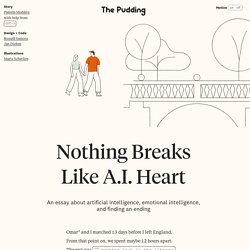
Given a prompt like, “Hello my name” the model will, more often than not, suggest that the next word is is. It happens to be the biggest publicly released model of its kind: 175 billion parameters (although access is gated through an API with strict use case guidelines). You can think of a parameter roughly as a synapse; the human brain has around 100 trillion of those, but it has to focus on lots of things besides language, like swiping on dating apps and moving to San Francisco. To learn all of those parameters, GPT-3 is trained on hundreds of billions of sentences and stories from the Internet and books. Written something on Reddit? The model learns the toxicity of these forums. And, that’s just what I asked for. Critics Parul Sehgal and Teju Cole on the changing authority of words. The writers reflect on the strenuous, theatrical, and brutally confessional craft of contemporary criticism in Document S/S 2019.

This conversation appears in Document No. 14, available for order online now. Why do we like what we like? The books, movies, photos, and artworks that form our perspective—who puts them in front of us? One answer is the critic, that cipher of taste who places art in its various corridors, then augments, defines, degrades, and ultimately shapes the works that shape us. In times when the public’s eye travels with ever more scope but not necessarily more depth, criticism, the act of choosing—and so much more—becomes more important than ever. At only 37, Sehgal is re-centering literature from her position as literary critic and columnist at The New York Times. Is it a clash over writing... Last spring, a small circle of writers and scholars eagerly pored over a new book by Maxine Hong Kingston, the best-selling author of “The Woman Warrior” and “China Men.”
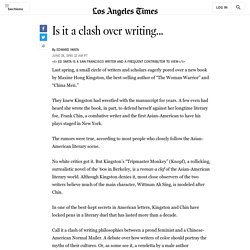
They knew Kingston had wrestled with the manuscript for years. A few even had heard she wrote the book, in part, to defend herself against her longtime literary foe, Frank Chin, a combative writer and the first Asian-American to have his plays staged in New York. The rumors were true, according to most people who closely follow the Asian-American literary scene. No white critics got it. Volume of Robert Frost’s Letters Renews Debate About His Character. The new collection will contain hundreds of little seen or entirely unknown letters discovered languishing in poorly cataloged archives, tucked away in books or forgotten in attics.
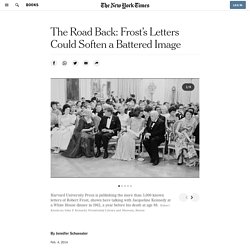
One cache of letters turned up in a desk donated to a thrift shop near Hanover, N.H., where they became the focus of a stolen property investigation. The first volume begins in 1886, with a charming note from 12-year-old Frost to a childhood sweetheart, and follows him through marriage to his wife, Elinor; a hard decade as a farmer in New Hampshire; three years in England; and return home in 1915, when he became a late-blooming literary star with the success of his second collection, “North of Boston.” It contains little family correspondence (no letters to Elinor are known to survive) and few letters that touch on difficult family matters. Book Review: ‘Consent,’ by Vanessa Springora. That feeling of fatedness is reinscribed by Springora the shaper of this tale, who begins the book with references to fairy tales, imagining Snow White refusing the temptation of the shiny red apple, Sleeping Beauty resisting the spindle — impossible, the tacit message.
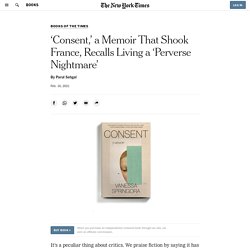
Impossible, too, to contemplate that hungry 14-year-old girl rebuffing G.M. When Talking About Poetry Online Goes Very Wrong ‹ Literary Hub. I’ve been thinking a lot, lately, about the example of Ciaran Carson, the Irish poet born in 1948, who wrote (like the rest of his generation from the North) in the immediate shadows of Seamus Heaney and Michael Longley, and who died in October 2019.
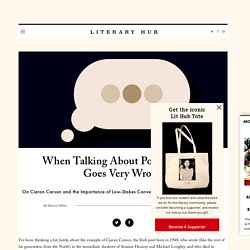
I got to know Ciaran just a bit in 2013 when I was on a Fulbright to the Seamus Heaney Centre, which Ciaran had come to direct after many years as a freelance journalist, prose writer, translator, and poet. He was wry and dry-humored and always impeccably dressed. (Word is he had an attic absolutely packed with three-piece suits.) He also played flute and tin-whistle at Madden’s Bar on Tuesday nights with his wife Deirdre and whoever else showed up for the evening’s “trad session”—a casual, improvised collective playing (“performance” isn’t quite the right word) mostly turned inward toward the space the musicians were gathered around, rather than outward toward the bar’s patrons.
Loading Ad Next Video Cancel Autoplay is paused. The Tangerine Magazine - Belfast. Sally Rooney’s ‘Normal People’ - The White Review. Sally Rooney’s ‘Normal People’ Reading Sally Rooney’s second novel Normal People is a compulsive experience.

After the navy blue Faber & Faber proofs were sent out in early summer, a trickle of people began to post online about having finished it in a single day, often accompanied by tears of recognition and complicated nostalgia for their own early romantic experiences. How Should a Millennial Be? “The great millennial novelist”—the mantle has been thrust, by Boomers and Gen Xers alike, upon the Irish writer Sally Rooney, whose two carefully observed and gentle comedies of manners both appeared before her twenty-eighth birthday.
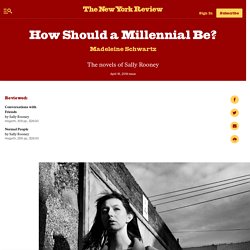
With this mantle have come prizes and money. Nearly every review has mentioned at least the prizes. Cozy in scope and romantic in spirit, the novels are mild and tender portraits of Irish college students in the recent present. In the first, Conversations with Friends, Frances and Bobbi, two best friends in their early twenties who used to date and occasionally sleep together, fall for Nick and Melissa, a couple in their thirties.
Frances begins an affair with Nick, threatening her relationship with Bobbi and allowing her to find some independence. Normal People halves the action. Both books take place around Trinity College, Dublin, and are populated by witty and sensitive students who e-mail a lot. Continue reading for just $1 an issue. View Offers. The Making of a Millennial Woman - Another Gaze: A Feminist Film Journal. Being a millennial feels like being stuck in a permanent state of on-the-cusp adolescence.
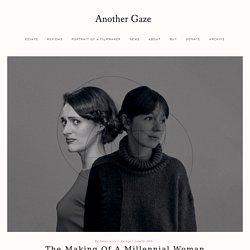
Sulky, prickly, and painfully hyper-visible, our every movement is tracked by a set of watchful guardians eager to land the next rage-inducing viral headline.i We don’t like napkins says Business Insider; we like tiny houses, declares CNN. Goldman Sachs notes that more of us are “choosing” to live with our parents, while an opinion piece in the Guardian asks why we’re not trying to have children.
No wonder we purportedly all have anxiety disorders and an insatiable love for killing heritage industries. One of the few things associated with millennials to have received a positive public reception is a particular form of millennial art. This art revolves around an archetypical Young Millennial Woman – pretty, white, cisgender, and tortured enough to be interesting but not enough to be repulsive. Rebecca Liu is digital assistant at Prospect and one of Another Gaze‘s staff writers.
Mary-Kay Wilmers: 'I like difficult women. Not just because I'm a bit difficult myself. I like their complication' In the London Review of Books filing system at their Bloomsbury offices, there is a proof copy of an early 1980s article written by a neurologist about a patient whose apprehension of the world around him had become bizarrely skewed.
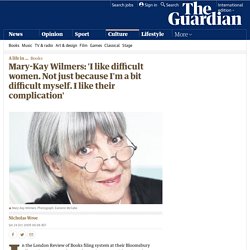
Above the piece was a "perfectly acceptable if rather bland headline", recalls one former member of staff. "And you can see how Mary-Kay has drawn a line through it and written a new headline. " "The man who mistook his wife for a hat" went on to became the title piece of Oliver Sacks's bestselling book and not only showed Wilmers's editorial flair and facility for the eye-catching headline, but also prefigured some of her, and the LRB's, preoccupations over the coming decades.
Wilmers helped launch the paper, as she insists on calling it, in 1979, and as it celebrates its 30th anniversary she has been sole editor for 17 years. "I like memoir," explains Wilmers. Mary-Kay Wilmers was born in 1938 and brought up on Long Island Sound, near New York. The Reading Life with Parul Sehgal, Book Critic at The New York Times. While I couldn’t agree more with Sarton’s diagnosis—how psychically disruptive it is to step away from one’s computer, rejoin the world, talk, be intelligible, order from a menu—early in October, I suggested exactly that. I was meeting Parul Sehgal, former editor and columnist at The New York Times Book Review, who in July of this year, joined the publication’s team of critics following Pulitzer Prize winning Michiko Kakutani’s decision to step down as the Times’ chief book critic.
Kakutani, described by Vanity Fair upon her departure as “the most powerful book critic in the English-speaking world,” and at, it’s worth noting, the last daily newspaper in America with a separate books section, held the position for nearly four decades. “You are extremely singular,” Sehgal says as we settle into our table at an Italian restaurant in Fort Greene, owned by a man from Kerala, she tells me. “I don’t leave the house in the day. My husband was like, “Where are you going!?” How Mary-Kay Wilmers Became Britain’s Most Influential Editor. Wilmers has often said in print, repeating a variation of it to me, that the L.R.B. was the creation of its co-founder, Karl Miller, a London literary editor, and that she “kept it up” after his departure, in 1992. “Certainly it wasn’t my intention to change it,” she writes in the introduction to “London Review of Books: An Incomplete History,” published this month. The novelist and journalist John Lanchester, a contributor to the L.R.B. for 32 years who started out, as many of the paper’s editors have, as an editorial assistant, disputed Wilmers’s claim.
“It isn’t even slightly true for Mary-Kay to say that about merely perpetuating what Karl brought,” Lanchester wrote in an email. “They had worked together for a long time already, and the editorial character of the L.R.B. was always an amalgam. How I Get It Done: Parul Sehgal, New York Times Book Critic. Parul Sehgal. Illustration: Lauren Tamaki. The Paris Review - Cavafy’s Bed - The Paris Review. What We Get Wrong About Joan Didion.
Politics had come to be programming produced for élites, by élites, in a bubble disconnected from others. If this warning seemed eccentric on the eve of electing an institutional Vice-President and, four years later, the Man from Hope, it does not seem so today. The problem Didion first identified in 1967 has been treated as a revelation in recent years. Her position as a disaffected insider—hanging out with the Doors but crying foul on the Summer of Love, writing for the newsstand but declaiming its idiocy—made her an aggressive contrarian. Fictional Notes toward an Essay on Translation - Asymptote. Isn’t that your author? My husband says as he sits down. I turn around and look out at the crowded restaurant. It is February, and Seoul has not borne the brunt of the pandemic yet.
I turn back to my husband and ask, Which author? Shin? Joan Didion: Why I Write ‹ Literary Hub. Of course I stole the title for this talk from George Orwell. One reason I stole it was that I like the sound of the words: Why I Write. There you have three short unambiguous words that share a sound, and the sound they share is this: Susan Sontag on the Trouble with Treating Art and Cultural Material as “Content” “There are no facts, only interpretations,” Nietzsche wrote in his notebook in the late 1880s. Ursula K. Le Guin on Where Ideas Come From, the “Secret” of Great Writing, and the Trap of Marketing Your Work. Since long before the question of where good ideas come from became psychologists’ favorite sport, readers, fans, and audiences have been hurling it at authors and artists, much to their frustration.
A few brave souls like Neil Gaiman, Albert Einstein, and David Lynch have attempted to answer it directly, or in Leonard Cohen’s case to delightfully non-answer it directly, but none have done so with greater vigor of mind and heart than Ursula K. Interview with Sianne Ngai - The White Review. Interview with Sianne Ngai. Translation in the First Person - The White Review. On attachment, detaching, and ordinary life.
Poetry. “Write a Sentence as Clean as a Bone” And Other Advice from James Baldwin ‹ Literary Hub. Ninety-four years after his birth (and more than thirty since his death) James Baldwin remains an intellectual, moral, and creative touchstone for many Americans—whether writers, critics, or simply people trying to live well in the world. Larissa Pham. The Paris Review - Blog Archive We Didn’t Have a Chance to Say Goodbye - The Paris Review. The Paris Review - Blog Archive Why Do We Keep Reading ‘The Great Gatsby’? The Question of Race in Beowulf. Want to Feel Better? Stop Reading New Books. ‹ Literary Hub. The 89 Best Book Covers of 2020 ‹ Literary Hub. The Paris Review - Blog Archive The Myth of Self-Reliance - The Paris Review. Should Writers Avoid Sentimentality? Paris Desert, Tokyo Mirage. Mieko Kawakami. Anne Carson · Poem: ‘Oh What A Night (Alkibiades)’ · LRB 19 November 2020.
Fungi, Folklore, and Fairyland. Subrealism - BOMB Magazine. Revolutionary Letter #4 by Diane di Prima. Three Poems by Molly Brodak - NY Tyrant. The Paris Review - Blog Archive U Break It We Fix It - The Paris Review. The Paris Review - Blog Archive Williams Found Plums in the Icebox—Do They Belong There? On Water - The White Review. Poem of the week: Extract from The Walls Do Not Fall by HD. Anne Carson: The Sheer Velocity and Ephemerality of Cy Twombly. On the trail of the real Pied Piper. The Paris Review - Blog Archive It’s Time to Pay the Piper - The Paris Review.
The Paris Review - Blog Archive The View Where I Write - The Paris Review. The Paris Review - Blog Archive The Second Mrs. de Winter - The Paris Review. All the Better to Hear You With. Rapunzel, Draft One Thousand. Has Self-Awareness Gone Too Far in Fiction? Is This the End of Writing in Cafés? How Zadie Smith’s New Essay Collection Captures The Unrest And Anxiety Of The Covid-19 Era.
Edmund White Thinks Most People Misread ‘Lolita’ The Celebrity Bookshelf Detective Is Back. A Bookstore That Shines as ‘a Lighthouse of a Free Society’ The Inscrutable Brilliance of Anne Carson. The Unfolding. Every Great Writer is a Great Deceiver: Vladimir Nabokov's Best Writing Advice. Why Do Some Mathematicians Think They're Poets? In echo of Mao era, China's schools in book-cleansing drive.
I’m So Tired. Ottessa Moshfegh's Year of Anything But Rest and Relaxation. The Untranslatable. On Translationese. The Linguistic Case for Sh*t Hitting the Fan. The self-conscious drama of morality in contemporary fiction - Lauren Oyler - Bookforum Magazine. What Color Is the Sky? None of Us Are Normal. Aiming Smaller: An Interview with Jenny Zhang. Literary Paper Dolls: Clarissa. The Voice of God. (And Knausgaard, Whitman, Machiavelli … ) Remembering Seamus Heaney - Robert McNamara - Medium.
What Everybody Gets Wrong About Shirley Jackson. A Dandy’s Guide to Decadent Self-Isolation. The end of coronavirus: what plague literature tells us about our future. Read Joan Didion’s savage roast of J.D. Salinger’s Franny and Zooey. How It Feels by Jenny Zhang. In Her Book Sour Heart, Jenny Zhang Arrives as a Chinese-American Voice We Haven’t Heard Yet. Both absent and present by Will Harris. An Ode to Women Who Walk, From Virginia Woolf to Greta Gerwig. Zadie Smith Answers the Proust Questionnaire. Red Brocade by Naomi Shihab Nye - Poems. ‘The Empathy Exams,’ by Leslie Jamison.
Magazine Included A Gas Stove In Sylvia Plath-Inspired Fashion Spread - NYLON. Vice Published a Fashion Spread of Female Writer Suicides [Updated] Cult of the Literary Sad Woman. Literary Fictions vs Genre Fiction. We Need to Talk About Zadie Smith: Why an Entire Generation Quit Writing. How Mary-Kay Wilmers Became Britain’s Most Influential Editor. Culture - The cult books that lost their cool. Cracks. Interview: The very, very private life of Ms Donna Tartt. In “The Secret History,” Dressing Well Has Murderous Possibilities. Virginia Woolf’s Pivotal Sophomore Novel.
Mary Oliver Poems: “Moccasin Flowers” Why Teaching Poetry Is So Important. Mary Oliver's Poetry Captures Our Relationship With Technology.